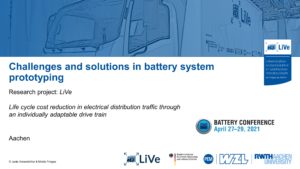Summary:
Within the framework of the research project „Lebenszykluskostenreduktion im elektrischen Verteilerverkehr durch individuell adaptierbaren Antriebsstrang“ (LiVe), modular battery systems for commercial vehicles are being developed at the PEM of the RWTH Aachen University.
Based on the proclaimed project objective of optimizing life cycle costs, different core requirements for battery system development were defined:
• Modularity and scalability
• Re-X capability
• Excellent temperature control
Based on the project environment as well as the defined project goals, different approaches were investigated and iteratively approached a modular concept for tab-cooled pouch cells. The cooling of pouch cells directly at the battery tabs allows to dissipate heat very efficiently as the cell tabs are directly welded to the Al-/Cu-sheets inside the cell. The core idea of the approach was to contact the cell tabs by laser welding, but at the same time to allow separation of the joining points by means of exchangeable cell holders, thus enabling remanufacturing of the battery modules.
The development took place virtually and iteratively in CAD models. Early on, methods of rapid prototyping were integrated into the development process. Using 3D printing, the first primotypes (a preliminary stage of a prototype) of individual components were quickly available. In these primotypes the developed concepts could be tested at an early stage. The findings then went directly into the development process. The complexity of the primotypes was continuously increased. The cell holders could be developed efficiently by this process from virtual drafts via first printed versions up to the finished injection molded part.
In addition to the functional prototypes, manufacturing aspects were also included in the development process at an early stage. For example, the laser-welded connection of the cell holders was simulated using sheets of the same material and dimensions. The welding parameters could thus be varied and optimized in detail. This means that detailed process knowledge was already available with regard to the joining of the real battery cells, and safety during welding and durable electrical contact between the cells was increased.
Following the virtual development, the battery system could be set up in reality. The pouch cells, as well as some other electrical and electronic components were purchased. Especially in the field of mechanical components, the production and assembly could be realized directly at the chair or in a close network. In the environment of the development and construction of the battery system numerous potentials could be identified, which will be used in further development generations. The potentials are to be located on the one hand methodically, on the other hand in the practical implementation.
We are happy to forward your request / feedback.

